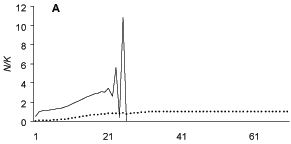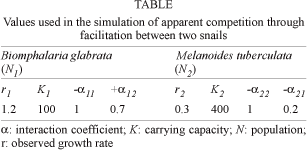Interactions between two species that result in reduced growth rates for both and extinction of one of the species are generally considered cases of asymmetric interspecific competition. Exploitative or interference competition is the usual mechanism invoked. Here we describe another mechanism producing the same result, named apparent competition through facilitation (ACF), observed between Melanoides tuberculata and Biomphalaria glabrata populations. The superior competitor actually gives some benefit to the other species, whose population becomes unstable with progressively increasing oscillations, leading to extinction. A model of ACF using difference equations suggests initial dynamics distinct from traditional interspecific competition. The dynamics of two freshwater snails in the field and in laboratory experiments suggest ACF, and these relations should be considered in studies of schistosomiasis control. ACF could occur in natural populations, but might have gone undetected because the final result is similar to traditional interspecific competition.
apparent competition; population interactions; Biomphalaria glabrata; Melanoides tuberculata; schistosomiasis control





